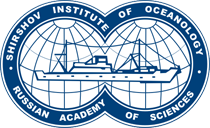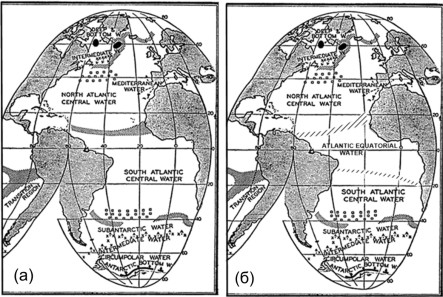One of the most surprising properties of ocean water is the close relationship between temperature and salinity, with vertical profiles of temperature and salinity measured over hundreds or even thousands of kilometers showing a similar relationship between temperature and salinity. A volume of ocean water that exhibits a similar temperature-salinity relationship is considered a separate water mass.
In the World Ocean, water masses vary depending on their geographical location and origin. Ocean water masses have been actively studied since the 1930s and, it would seem, everything is known about them. In particular, in the middle and low latitudes in the upper active layer of the World Ocean, where the temperature decreases with depth by more than 10°C (the main thermocline, located at a depth of approximately 100–600 m), central and equatorial water masses are distinguished. The central water masses are located in the main thermocline in the subtropical gyres in the latitude range 10°–40° in both hemispheres, and the equatorial waters are closer to the equator.
Since the appearance of Sverdrup’s classic monograph “Oceans...” (Sverdrup et al., 1942), for more than 80 years it has been believed that the equatorial water mass exists only in the Pacific and Indian oceans, and the place of the Atlantic Equatorial Water mass (AEW) is occupied by the South Atlantic Central Water mass (SACW). In this case, the boundary between the SACW and the central water of the northern hemisphere (CWNH) is located approximately at 10° N latitude. However, in 1998 the Argo program was launched. Argo floats drift along with ocean currents at a depth of 1000–2000 m, periodically rising to the surface to transmit measurement data to a satellite.
To date, more than 2 million vertical temperature and salinity profiles have been collected using Argo floats, more or less uniformly distributed over the area of the oceans. Employees of the Institute of Oceanology RAS V.M. Zhurbas, K.V. Lebedev and N.P. Kuzmina used two decades of massive Argo data to construct a volumetric TS diagram - an extremely detailed distribution of the volume of water in the Atlantic depending on temperature and salinity. As a result, they were able to isolate a previously undetected water mass - AEW. The volume of AEW is comparable to the volumes of SACW and CWNH and is enormous - about 4 million cubic kilometers.
The discovery of AEW made it possible to fill the gap that existed for 80 years in the phenomenological picture of the main water masses of the World Ocean.
The result is published in the article
Zhurbas V., Lebedev K., Kuzmina N. Is there the Equatorial Water mass in the Atlantic Ocean? // Geophysical Research Letters. 2023. Vol. 50. e2023GL104866. DOI: 10.1029/2023GL104866
Boundaries of upper Atlantic water masses according to Sverdrup et al. (1942) before (a)
and after (b) the discovery of the Atlantic equatorial water mass.




